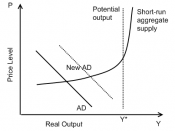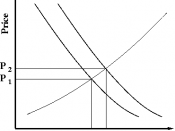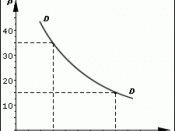This paper examines the economic factor at work in supply and demand of rental apartments in the city of Atlantis. Acting as the property manager for GoodLife Management in Atlantis, the simulation asks the user to make pricing and supply decisions based on changes in the market. Changes in price, population, average salaries, tastes, and government regulations all affect the market in a number of ways.
Decisions affected by Changes in Supply and DemandThe first decision is what price to set the monthly rental at to maximize revenue and lower vacancies to as low as possible. Lowering the rent by about 200 hundred dollars lowered the vacancy rate down to 5% and increased revenue by about $100,000. The manager achieved this because of the inversely proportional relationship of price to quantity demanded. He rented more apartments as the price went down.
The next two scenarios ask the manager to determine what price at which he would be willing to rent out 2500 apartments.
The shape of the supply curve determined that GoodLife Management would be willing to supply 2500 apartments at $1550. They would need to charge that much to cover escalating incremental costs. This would be problematic, however, because the demand for apartments is much lower at that price. The intersection, or equilibrium, of the two curves suggests a price of $1050 at which the quality demanded would be 2000 apartments.
When Lintech Inc. moved its operations in to Atlantis, the demand for rental apartments increased, shifting the demand curve to the right, and supply remained unchanged. GoodLife increased the price of their apartments to $1400 in order to balance the demand for their apartments to the price at which they were willing to supply them economically. At this rate, they were able to lease 2350 apartments.
When Lintech...



Sort of helpful
In getting an idea of what the simulation is about, this paper did provide the results. However, it was kind of a paper that lacked direction or flow of the paper.
1 out of 1 people found this comment useful.